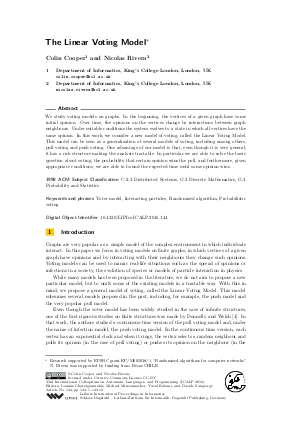The Linear Voting Model
Authors Colin Cooper, Nicolás Rivera
-
Part of:
Volume:
43rd International Colloquium on Automata, Languages, and Programming (ICALP 2016)
Part of: Series: Leibniz International Proceedings in Informatics (LIPIcs)
Part of: Conference: International Colloquium on Automata, Languages, and Programming (ICALP) - License:
 Creative Commons Attribution 3.0 Unported license
Creative Commons Attribution 3.0 Unported license
- Publication Date: 2016-08-23
File

PDF
LIPIcs.ICALP.2016.144.pdf
- Filesize: 443 kB
- 12 pages
Document Identifiers
Subject Classification
Keywords
- Voter model
- Interacting particles
- Randomized algorithm
- Probabilistic voting
Metrics
- Access Statistics
-
Total Accesses (updated on a weekly basis)
0Document
0Metadata
Abstract
We study voting models on graphs. In the beginning, the vertices of a given graph have some initial opinion. Over time, the opinions on the vertices change by interactions between graph neighbours. Under suitable conditions the system evolves to a state in which all vertices have the same opinion. In this work, we consider a new model of voting, called the Linear Voting Model. This model can be seen as a generalization of several models of voting, including among others, pull voting and push voting. One advantage of our model is that, even though it is very general, it has a rich structure making the analysis tractable. In particular we are able to solve the basic question about voting, the probability that certain opinion wins the poll, and furthermore, given appropriate conditions, we are able to bound the expected time until some opinion wins.
Cite As Get BibTex
Colin Cooper and Nicolás Rivera. The Linear Voting Model. In 43rd International Colloquium on Automata, Languages, and Programming (ICALP 2016). Leibniz International Proceedings in Informatics (LIPIcs), Volume 55, pp. 144:1-144:12, Schloss Dagstuhl – Leibniz-Zentrum für Informatik (2016)
https://doi.org/10.4230/LIPIcs.ICALP.2016.144
BibTex
@InProceedings{cooper_et_al:LIPIcs.ICALP.2016.144,
author = {Cooper, Colin and Rivera, Nicol\'{a}s},
title = {{The Linear Voting Model}},
booktitle = {43rd International Colloquium on Automata, Languages, and Programming (ICALP 2016)},
pages = {144:1--144:12},
series = {Leibniz International Proceedings in Informatics (LIPIcs)},
ISBN = {978-3-95977-013-2},
ISSN = {1868-8969},
year = {2016},
volume = {55},
editor = {Chatzigiannakis, Ioannis and Mitzenmacher, Michael and Rabani, Yuval and Sangiorgi, Davide},
publisher = {Schloss Dagstuhl -- Leibniz-Zentrum f{\"u}r Informatik},
address = {Dagstuhl, Germany},
URL = {https://drops.dagstuhl.de/entities/document/10.4230/LIPIcs.ICALP.2016.144},
URN = {urn:nbn:de:0030-drops-62883},
doi = {10.4230/LIPIcs.ICALP.2016.144},
annote = {Keywords: Voter model, Interacting particles, Randomized algorithm, Probabilistic voting}
}
Author Details
References
-
Petra Berenbrink, George Giakkoupis, Anne-Marie Kermarrec, and Frederik Mallmann-Trenn. Bounds on the voter model in dynamic networks. arXiv preprint arXiv:1603.01895, 2016.

-
Colin Cooper, Robert Elsasser, Hirotaka Ono, and Tomasz Radzik. Coalescing random walks and voting on connected graphs. SIAM Journal on Discrete Mathematics, 27(4):1748-1758, 2013.

-
Josep Díaz, Leslie Ann Goldberg, George B Mertzios, David Richerby, Maria Serna, and Paul G Spirakis. Approximating fixation probabilities in the generalized moran process. Algorithmica, 69(1):78-91, 2014.

-
Peter Donnelly and Dominic Welsh. Finite particle systems and infection models. Mathematical Proceedings of the Cambridge Philosophical Society, 94(01):167-182, 1983.

-
Rick Durrett. Probability: theory and examples. Cambridge university press, 2010.

-
Yehuda Hassin and David Peleg. Distributed probabilistic polling and applications to proportionate agreement. Information and Computation, 171(2):248-268, 2001.

-
David Asher Levin, Yuval Peres, and Elizabeth Lee Wilmer. Markov chains and mixing times. AMS Bookstore, 2009.

-
Toshio Nakata, Hiroshi Imahayashi, and Masafumi Yamashita. Probabilistic local majority voting for the agreement problem on finite graphs. In Computing and Combinatorics, pages 330-338. Springer, 1999.

-
Roberto Oliveira. On the coalescence time of reversible random walks. Transactions of the American Mathematical Society, 364(4):2109-2128, 2012.

-
Roberto Oliveira. Mean field conditions for coalescing random walks. The Annals of Probability, 41(5):3420-3461, 2013.

